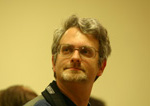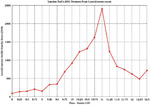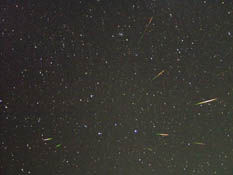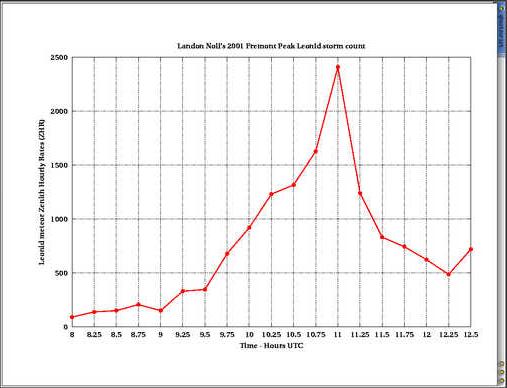





|
|
|
Leonid 2001 meteor shower / squall / storm at Fremont Peak |
||
| [chongo's home] [Astronomy] [Mathematics] [Prime Numbers] [Programming] [Technology] [contacting Landon] | ||
While some call the 2001 Leonids a great shower, others call it a storm. Perhaps the term Leonid squall is in order?
Observing conditions were outstanding at Fremont Peak. The limiting magnitude was between 6.7 and 7.0. Many faint stars within Orion could be directly seen. Many experienced observers reported directly seeing more of their reference brightness stars than ever before.
Somewhat after the peak we noticed a faint sky glow near the horizon. The glow was uniform in all directions, for about 10 to 15 degrees dec. The glow was in stark contrast to the very dark zenith. Perhaps this glow was due to light scattering off of the excess dust in the upper atmosphere from the many meteor strikes?
In short, the even was absolutely astounding! Numerous fireballs, some exploding Leonid meteors were seen during the peak of the shower. The peak period (1000 - 1130 UTC) definitely came in clumps. Even at its height, one would see a pause of 2-3 seconds followed by a burst of 3-5 meteors. There were lots of slow bright burning meteors with long streams from the Leo radiant.
What did it look like? Here is an image was taken by Kazuyuki Tanaka in Japan on 19 Nov 2001 (as shown in Sky & Telescope's News section):

Scenes like that were common at Fremont Peak! At times during the peak, there were busts where this many meteors could be seen at one time radiating from the the Constellation Leo.
The following table shows the meteor counts as compiled by Landon Curt Noll:
| PST Time | UTC Time | Count | Count/hour |
|---|---|---|---|
| 0000-0015 | 0800-0815 | 23 | 92 |
| 0015-0030 | 0815-0830 | 35 | 140 |
| 0030-0045 | 0830-0845 | 38 | 152 |
| 0045-0100 | 0845-0900 | 52 | 208 |
| 0100-0115 | 0900-0915 | 38 | 152 |
| 0115-0130 | 0915-0930 | 83 | 332 |
| 0130-0145 | 0930-0945 | 87 | 348 |
| 0145-0200 | 0945-1000 | 170 | 680 |
| 0200-0215 | 1000-1015 | 230 | 920 |
| 0215-0230 | 1015-1030 | 308 | 1232 |
| 0230-0245 | 1030-1045 | 329 | 1316 |
| 0245-0300 | 1045-1100 | 407 | 1628 |
| 0300-0315 | 1100-1115 | 602 | 2408 |
| 0315-0330 | 1115-1130 | 310 | 1240 |
| 0330-0345 | 1130-1145 | 208 | 832 |
| 0345-0400 | 1145-1200 | 186 | 744 |
| 0400-0415 | 1200-1215 | 156 | 624 |
| 0415-0430 | 1215-1230 | 122 | 488 |
| 0430-0445 | 1230-1245 | 180 | 720 |
The following graph:

(click to enlarge)
compares well with the Mt. Lemmon Observing Facility results as well as the predictions published in Sky and Telescope.
|
© 1994-2013
Landon Curt Noll chongo (was here) /\oo/\ $Revision: 8.1 $ $Date: 2022/07/08 00:19:55 $ |